Retiring Former Research Chimps
Amy Fultz, Chimp Haven
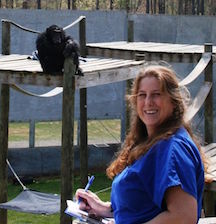 The Director of Behavior and Research at Chimp Haven joins Animal Radio to talk about the many chimps that are now living at the sanctuary in Louisiana. Amy Fultz is currently fundraising to help build more habitats in the 200-acre refuge. Chimp Haven consists of 200 acres within a larger nature park.
The Director of Behavior and Research at Chimp Haven joins Animal Radio to talk about the many chimps that are now living at the sanctuary in Louisiana. Amy Fultz is currently fundraising to help build more habitats in the 200-acre refuge. Chimp Haven consists of 200 acres within a larger nature park.
So where did the chimps at Chimp Haven come from? Did they start out as pets and then their owners realized they could no longer handle them as they grew older? Amy Fultz tells us that they only have one chimp that was in a pet situation. Most of their chimpanzees are actually retired from biomedical research in the United States.
The chimps that were in research labs we're actually born, or lived most of their life, under fluorescent lights. Amy explains that some of the chimps were actually brought in from Africa back in the late sixties or early seventies and some were born in captivity. There are also chimps that were used in different ways and were utilized in cognitive research in a university setting as well.
Their two oldest chimps are Jacob and Sarah and they're both 59. Chimps can live into their fifties or sixties. They're considered elderly typically after the age of 35. But, they definitely have lots of them that are over 35 and in their forties.
Right now they have over 240 chimpanzees and they're regularly retiring additional chimpanzees on a monthly basis. They'll stop that in the summer because it gets too hot in Louisiana to continue transporting the latest chimps, who are actually coming from New Mexico from a place called Alamogordo Primate Foundation. They've been retiring the chimps over the last year or so from that organization. Once the chimps come to Chimp Haven, this will be their final home and they'll be there until the end of their lives.
 Having being brought up in an environment of scientific research, it is thought that maybe some of these chimps are un-socialized and hate humans. Amy explains that every facility is different. And just like people have very different personalities, some of us are very cantankerous and others are very friendly and sociable, well these chimps are sort of the same way. She sometime thinks it may have nothing to do with how they were treated, but just their own intrinsic personality in terms of how they react to others, both other chimps and people. But certainly some of them really don't want to have much to do with humans unless they have food or goodies for them.
Having being brought up in an environment of scientific research, it is thought that maybe some of these chimps are un-socialized and hate humans. Amy explains that every facility is different. And just like people have very different personalities, some of us are very cantankerous and others are very friendly and sociable, well these chimps are sort of the same way. She sometime thinks it may have nothing to do with how they were treated, but just their own intrinsic personality in terms of how they react to others, both other chimps and people. But certainly some of them really don't want to have much to do with humans unless they have food or goodies for them.
Surprisingly, there are more chimpanzees that are currently living in sanctuaries than remain in these research facilities, which Amy explains is a recently reached milestone. This is a big deal and that number keeps going up in terms of more chimps being moved to sanctuaries.
Even though research on chimps in laboratories is slowly coming to a halt, Amy states that it takes awhile for the process in order to get them moved to sanctuaries. They can't just take 100 chimps and take them and pop them into the sanctuary. The chimps first have to make the trip. They also have to be very careful and keep the animal's welfare in mind the whole entire time. Plus, the trucks can only hold typically six to nine chimps at a time.
When the chimps make it to Chimp Haven, they have to go through a quarantine process. Many of the chimps are coming in smaller groups and they have to be integrated into larger ones. So they're doing introductions and they have to give them time to acclimate. Just like if you think about it from the standpoint of a person moving to a new country for the first time, it takes a little while for them to get used to that culture and acclimate to the area and the time change, etc. It's sort of the same for the chimps. They've got new caregivers. They might be experiencing new foods for the first time. It's a different climate. So they're adjusting and that takes a little bit of time and they have to give them time to do that before they can bring in the next shipment.
 If you would like to work around chimpanzees, you can volunteer at Chimp Haven, if you can come on a regular basis. Another thing they do is six days out of the year they have Chimpanzee Discovery Days where they open up select parts of the sanctuary to the public and people can come and talk to their staff and meet some of the chimps. They also have an event called the Chimp, Chat & Chew, where it's a little bit more intimate and you get to talk with a staff member and then get a behind the scenes tour as well. Amy tells us that those events sell out really fast!
If you would like to work around chimpanzees, you can volunteer at Chimp Haven, if you can come on a regular basis. Another thing they do is six days out of the year they have Chimpanzee Discovery Days where they open up select parts of the sanctuary to the public and people can come and talk to their staff and meet some of the chimps. They also have an event called the Chimp, Chat & Chew, where it's a little bit more intimate and you get to talk with a staff member and then get a behind the scenes tour as well. Amy tells us that those events sell out really fast!
Amy works with many chimps so we ask her is she has any favorites. She tells us her all-time favorite, who is now deceased, was Mason. She also tends to favor male chimps that have a sense of humor, are a little goofy and tend to act a little bit like the little brother who's poking you in a manner of I'm not poking you kind of a thing. Her favorite living chimp right now is Matthew. In Amy's opinion, he is the most handsome chimp there and that's corroborated by others as well. She explains that they don't touch the chimps because they're so genetically similar to humans and therefore can actually share any upper respiratory viruses or stomach viruses and things like that. However, they do use long handled spoons to tickle them and play with them and Matthew loves to have you play with his feet. She tells us that a lot of people don't know that chimps actually do laugh. So you can get him laughing if you play with his feet and tickle him.
So what is a typical day in the life of chimps at Chimp Haven? Do they play with any electronics or iPads? Amy explains that what's most important to a chimpanzee is another chimp and being social with the other chimpanzees. However, when they have what are called interaction days with their caregivers, they might bring an iPad to show them a game, but that's a special kind of a treat. The chimps spend most of their time in their outdoor enclosures in the beautiful Louisiana weather and in the forested areas of the sanctuary just being chimps and living the chimp life.
Visit Website
The World's First Self-Cleaning Dog Potty Goes To The Rescues
Alan Cook, BrilliantPad
 Alan Cook, the inventor and mastermind behind the Brilliant Pad Self-Cleaning Dog Potty, is donating hundreds of potties to shelters and adopters across America. "By potty training shelter dogs, we're helping to make more dogs adoptable," says Cook. Shelters may apply here.
Alan Cook, the inventor and mastermind behind the Brilliant Pad Self-Cleaning Dog Potty, is donating hundreds of potties to shelters and adopters across America. "By potty training shelter dogs, we're helping to make more dogs adoptable," says Cook. Shelters may apply here.
About two years ago the BrilliantPad was introduced to the Animal Radio studios. Judy Francis was in charge of cleaning the dog potty and constantly replaced the soiled pads and washed the artificial grass. She had tried many different types of indoor dog potty products over the years, never finding anything that was easy and that she liked. She was always looking for the answer to this problem and then she had it. The BrilliantPad has made a big difference in her life and that of her dog's, Ladybug. She swears by this product and will never let anyone ever take it away!
BrilliantPad has been around several years now and is growing by leaps and bounds. They now they have a shelter program and Alan Cook, the Found and CEO of BrilliantPad, explains to us how it works.
Alan explains that they are so excited and happy to support the animal community by donating free products to animal rescue organizations and shelters. Adoption season is starting and shelters have all sorts of events and fundraisers, so they are donating free BrilliantPads to their friends in the animal community to support their fundraising activities.
 They are doing this three different ways. BrilliantPads will be given free to rescues and shelters for their silent auctions and raffles. They will also donate them to rescues and shelters for fundraisers and they get to keep all of the proceeds. They don't have to pay for them or give up any commissions. They get to keep all that they raise in their silent auctions and raffles.
They are doing this three different ways. BrilliantPads will be given free to rescues and shelters for their silent auctions and raffles. They will also donate them to rescues and shelters for fundraisers and they get to keep all of the proceeds. They don't have to pay for them or give up any commissions. They get to keep all that they raise in their silent auctions and raffles.
The second thing that BrilliantPad is doing is providing machines to be used in the shelter facilities and the homes of foster families. So they're doing their part to make taking care of these dogs even easier.
The third thing they're doing is giving away free BrilliantPads to people that adopt dogs from participating shelters and rescue organizations. All the shelter has to do is distribute a postcard that they provide in the adoption packet and BrilliantPad will do the rest.
BrilliantPad is a great company that puts their money where their mouth is and has not only created an amazing product, they're actually helping the animals out there get from shelters and horrible situations into families and wonderful situations.
They also know that one of the biggest challenges the animal community has in placing young dogs is the whole house training part. So in some cases, because the shelters and rescue homes are using the BrilliantPad, the dog is coming pre-potty trained. It's a nice point to the adopting family to make life that much easier when they get their new puppy home.
If you are working with a shelter or foster families and want to know how they can get involved, visit either brilliantpad.com/shelters or send an email to shelters@brilliantpad.com. Tell them a little bit about your shelter, what events you have coming up and let them know the best way to get in touch with you and they will get you set up.
 If you're not with a shelter, but you're pretty interested in how Judy's life has changed and this is something you want to think about visit brilliantpad.com.
If you're not with a shelter, but you're pretty interested in how Judy's life has changed and this is something you want to think about visit brilliantpad.com.
The BrilliantPad is now available on Amazon and Chewy. They will soon also be available at PetCo as well.
Alan tells us that the response to the product has been fantastic and they're really excited for the next steps in the company.
The BrilliantPad is not the first product that Alan has developed. He also invented the ScoopFree automatic litter system for cats. Alan says it great to hear from people who use these products and tell him how it makes life better and easier and healthier for them and their pets. They are continuing to work on lots of new stuff and looking forward to making things better for everybody.
If you want to get your shelter set up with the BrilliantPad, visit either brilliantpad.com/shelters or send an email to shelters@brilliantpad.com.
Visit Website
This Fencing Will Stop Your Dog From Climbing Over or Digging Under
Vinny Tonnage, Pet Playgrounds
 It's great if your animals can get outside in the sunshine and fresh air. You may like taking your dog out for walks, but it's not always possible. Perhaps you work many hours a day, so being able to put your dog outside for a few hours in a dog run or into a fenced area is great.
It's great if your animals can get outside in the sunshine and fresh air. You may like taking your dog out for walks, but it's not always possible. Perhaps you work many hours a day, so being able to put your dog outside for a few hours in a dog run or into a fenced area is great.
One type of fencing is an electric or invisible fence. However, there are a few fundamental problems with those. First is that they are electrified, which is just not cool on any level. Secondly, they fail 30-percent of the time. And lastly, while they can keep your animal in, they can't keep predators out. So if another dog without a collar comes in the yard or even a coyote, your dog is basically a sitting duck. So being able to protect your dog while allowing them outside is very important.
Another type of fencing is either wood or chain link. The problem with these is that if you have a digging dog, they are always able to dig under these types of fencing and escape.
Now there is another type of fence and Vinny Tonangi from Pet Playgrounds tells us all about their fence which has been around for 10 years. The Pet Playgrounds has a dog fencing system that is a real physical dog fence and not an electrical fence. The benefits are the materials that they are utilizing to construct that fence. So for dogs that dig, they actually have a dig guard. What that means is that their fence doesn't stop just because that's where your ground starts. It actually continues on further for one foot. So the material that they use is a mesh-like material that is bent in a backwards "L" shape towards you. Then they use stakes in the ground, called ultra hold ground stakes because they're shaped a certain way. So dogs can't simply rip them out of the ground with their paws.
 If you don't have a digger, but you have a climber, they can usually scale a wooden or chain link fence. Vinny explains that this is a problem that you are going to have with any traditional fence, whether it's a chain link, wood, aluminum, vinyl, composite, you name it. The reason is because these are rigid fences and dogs use them like ladders.
If you don't have a digger, but you have a climber, they can usually scale a wooden or chain link fence. Vinny explains that this is a problem that you are going to have with any traditional fence, whether it's a chain link, wood, aluminum, vinyl, composite, you name it. The reason is because these are rigid fences and dogs use them like ladders.
Some people think that they can solve this problem by getting a seven-foot or eight-foot tall fence. However, what they find is that their dog can still get over it. However, the Pet Playgrounds Dog fencing System physically moves and because it moves, dogs can't get a grip. A dog may then try to paw will at it and because the fence is moving, they can never actually climb over it. Will all of that pawing at the fence destroy it? Vinny explains that it is very, very rugged. Their standard dog fence comes in four, five and six foot heights. They also have a MAX strength, which is for dogs that really just get through everything. So you might have a dog that will chew through wood in your house and so forth, and you know that basically anything you put in front of them, they're going to chew through, so that's when you need the MAX fence. A chain-link fence, for example, has about a thousand PSI. That's what it can withstand. A wood fence can withstand about 550. The Pet Playground's standard dog fence can withstand 2,900 PSI and their Max strength can withstand 4,000.
You want one of these fences, but you're thinking how can that work in your yard, which is full of hills, uneven land and rocks? Vinny says this is a great problem to have with their fence and that's why they're so successful. They have lots of people that have boulders and uneven land. Because their fence is a mesh-based product, it can be very flexible. You can maneuver the material to conform to any shape you want. Because of that, you don't need to do any grading to yard, which is what most professional fence installers would recommend, because they simply don't know about this product. It doesn't matter if your yard isn't level. You can install the fence yourself or hire a professional.
A lot of people love this product because there's no digging or cement involved. For the Pet Playgrounds fence, you use a no-dig sleeve and then you use a medium sized sledgehammer to pound that in. You don't have to actually use any cement at all.
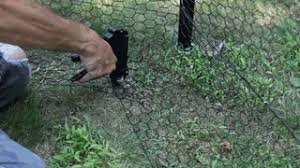 There is also no finding a truck and hauling all of the fencing equipment back to your house. You can just order everything online at Pet Playgrounds. If you already know what you want, you can go directly to playgrounds.com/order. You simply select the height you want, whether it's four, five, or six feet tall. Next you select the amount of linear feet you want. You can also order kits from a hundred linear feet to a thousand linear feet. You also order how many gates you want and that's it. In 10 days, the kit will be shipped to your doorstep and during the ordering process you can select whether you want a DIY (Do It Yourself) kit or you want to request a professional installer to call you to schedule an installation.
There is also no finding a truck and hauling all of the fencing equipment back to your house. You can just order everything online at Pet Playgrounds. If you already know what you want, you can go directly to playgrounds.com/order. You simply select the height you want, whether it's four, five, or six feet tall. Next you select the amount of linear feet you want. You can also order kits from a hundred linear feet to a thousand linear feet. You also order how many gates you want and that's it. In 10 days, the kit will be shipped to your doorstep and during the ordering process you can select whether you want a DIY (Do It Yourself) kit or you want to request a professional installer to call you to schedule an installation.
Another great thing about the Pet Playgrounds Dog Fencing System is that you can take it with you if you move. You will find a video at their website, which shows you how to easily remove the fence, pack it up and take it wherever you go.
Pet Playgrounds also has a special deal for Animal Radio listeners. If you order any kit that is 200 feet or more, you can put in the code ANIMALRADIO and save 10-percent off your entire DIY kit.
Visit Website
Rescuing The Dogs of China
Jeffrey Beri, No Dogs Left Behind
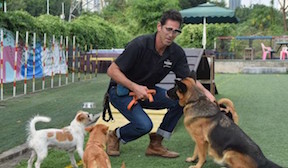 Jeffrey Beri founded the global animal rescue No Dogs Left Behind. He checks in with Animal Radio from China where he's rescuing thousands of dogs from a horrific life and ultimate slaughter. He reports that fortunately the Chinese are changing their view on pets.
Jeffrey Beri founded the global animal rescue No Dogs Left Behind. He checks in with Animal Radio from China where he's rescuing thousands of dogs from a horrific life and ultimate slaughter. He reports that fortunately the Chinese are changing their view on pets.
We fight the good fight right here on our own soil in the US for our companion animals. We're doing everything we can to help them find good situations, find homes, take them out of bad situations and educate people so that our pets may live a longer, healthier, happier life. But there are people that have gone beyond our soil to places like China.
No Dogs Left Behind is an emergency response unit that goes beyond borders, because as far as Jeffrey is concerned, rescue has no borders. It doesn't matter where it is that a dog's in need. They go there. Jeffrey is currently in China and has been there for the last two years assisting in emergency responses. He tells us they assisted in 619, which was an historical rescue of 1,300 dogs that were in desperate need of care and originally headed for the dog meat trade.
Jeffrey explains that there's a very serious matter in China and a dog's life there is very difficult, especially the larger breed dogs. This is because some of the larger breed dogs aren't even legal in some of the geographical locations. He is trying to educate the Chinese people on adoption programs and not buying dogs that have been bred, but instead to adopt dogs that are from rescues. Most of the dogs in rescues have been stolen and they are stolen from homes and even off the streets.
In China, they have these dogs that are collected from all over the place and then they're beaten and tortured and then ultimately eaten. The Chinese myth is that they believe that it's the summer solace and that eating these dogs will bring good health. They also believe that they'll warm their bodies up.
This is the 21st century and change is in order. No Dogs Left Behind believes in the sustainable component. They believe that it is critical to get these dogs to safety.
So what happens to these rescues? Are they adopted in China or are they all brought back to the United States? Jeffrey says both. They are working on educational awareness programs to educate the people of China to adopt versus buying dogs that have been bred. Then they believe that they need to take some of the dogs back to America because they have no chance in China.
 No Dogs Left Behind has shut down slaughterhouses and they've gone to truck interceptions where the trucks were heading to Yulin. Brave activists intercepted these trucks and then brought the dogs to specific locations. When these dogs get to these locations, they are virtually dying from distemper, parvo, exposure, extreme trauma of their bones from being exposed and being stuffed in these cages. They then go in and they implement five to ten tier treatment protocols where they separate the dogs and they educate the Chinese activists and shelters on how to enforce a western treatment protocol. And when they said that 80-percent would die, 80-percent have lived. So that's testament to No Dogs Left Behind in their treatment protocols.
No Dogs Left Behind has shut down slaughterhouses and they've gone to truck interceptions where the trucks were heading to Yulin. Brave activists intercepted these trucks and then brought the dogs to specific locations. When these dogs get to these locations, they are virtually dying from distemper, parvo, exposure, extreme trauma of their bones from being exposed and being stuffed in these cages. They then go in and they implement five to ten tier treatment protocols where they separate the dogs and they educate the Chinese activists and shelters on how to enforce a western treatment protocol. And when they said that 80-percent would die, 80-percent have lived. So that's testament to No Dogs Left Behind in their treatment protocols.
Jeffrey's been doing this for many years, so does he see the dog meat trade slowing down at all? Yes, he says he sees a very big change in the movement. And again, one of the main things is an education awareness program.
They have many students that come to No Dogs Left Behind and learning more about the dogs and how to maintain a lifestyle with a dog. He believes that the educational awareness program is key and fundamental to the change.
So does Jeffrey also see a paradigm shift in the way the Chinese are thinking about their animals especially companion animals? Again, yes he does. He says with conviction that he thinks that change is in order and he's seeing this happen literally in front of his eyes. In the past, dogs were always running free and now he's seeing many people walking their dogs on leashes and holding their dogs in their arms and taking much needed care of them.
To fund No Dogs Left Behind, Jeffrey states that they have a social media outreach and they are very blessed by fabulous donors who have contributed to the cause of ending the dog meat trade.
Visit Website
Get Your Pet To the Vet Safely with No Escapees - Dr. Debbie
 A frightening situation occurred the other day at my veterinary hospital. Working inside my office, I could hear a woman's shrieks coming from the parking lot. I ran outside to find a woman with one dog on a leash, and the other dog skittering about the parking lot - the result of a slipped collar. The owner would approach the panicked dog and he'd retreat, darting under nearby cars. Those familiar with our hospital location understand its proximity to a busy intersection. Should the dog run in the wrong direction, he'd meet up with 45 mph traffic.
A frightening situation occurred the other day at my veterinary hospital. Working inside my office, I could hear a woman's shrieks coming from the parking lot. I ran outside to find a woman with one dog on a leash, and the other dog skittering about the parking lot - the result of a slipped collar. The owner would approach the panicked dog and he'd retreat, darting under nearby cars. Those familiar with our hospital location understand its proximity to a busy intersection. Should the dog run in the wrong direction, he'd meet up with 45 mph traffic.
My staff was outside in moments to assist the owner in retrieving her dog and safely escorted everyone into the building. Thankfully my client's few minutes of terror ended uneventfully. But that's not always the case. I've seen dogs run straight into the road, cat's leap from a family member's arms, and owners dive into oncoming traffic trying to catch an escaping pet.
The lesson is simple. Don't underestimate your pets' fears. Fear of car travel, new places or the veterinary office can cause a pet to behave in unpredictable ways. If you know your pet to be nervous with new people or new situations, be especially vigilant when transporting your pet in a vehicle.
Identify Your Pet
Use two methods of identification for best insurance your pet is returned to you if lost. Permanent identification with a microchip is a must and should be complimented with a collar and ID tags.
Restrain Pet in Vehicle
Keep your pet secure during travel and when the car door opens by using a doggie seatbelt. Small dogs and cats should be housed in a pet carrier which is secured with seatbelt to avoid undue carrier movement during travel. Do not allow cats and small pets to roam freely in the car. Cats have been known to take cover under car seats which may require sedation or seat removal to extract kitty from her hiding place.
Check for Proper Fit


 A proper fitting collar allows 2 finger widths between the collar and pet's neck. Allow more than, and should your pet put on the brakes, he'll easily slip out of the collar. Poor fitting harnesses are just as dangerous and allow gap room which allows a back-peddling pet to wiggle out. Not sure if the collar is too loose? Snug the collar up one fitting in anticipation of your trip to the vet.
A proper fitting collar allows 2 finger widths between the collar and pet's neck. Allow more than, and should your pet put on the brakes, he'll easily slip out of the collar. Poor fitting harnesses are just as dangerous and allow gap room which allows a back-peddling pet to wiggle out. Not sure if the collar is too loose? Snug the collar up one fitting in anticipation of your trip to the vet.
Try Other Collar Styles
Even if you don't normally use a choker or pinch collar, consider using one when going to the vet's office. For thick necked dogs with smaller head size, try the Martingale collar, a fabric and metal combo collar that snugs down should your dog try to back out. Boisterous dogs that jump and leap when on leash may benefit wearing a head collar that fits over the muzzle. Ensure your collar choice is properly fitted, since any of these styles can fail if improperly fitted or used incorrectly.
Call Ahead
If you anticipate difficulties getting your pet to the vet's office, call ahead. Veterinary staff members are on the ready to help ensure your pet's visit is a safe one.
So, take a few minutes to consider your pet's travel safety before heading out on that next car trip, whether it is to the park, groomer or veterinary office. Your four legged friend will thank you, but may pout on the way there.
Featured veterinarian known as "Dr. Debbie" on national pet radio program, Animal Radio. Ebook author of "Yorkshire Terriers: How to Be Your Dog's Best Friend"; "Pugs: How to Be Your Dog's Best Friend"; "Mini Schnauzers: How to Be Your Dog's Best Friend"; and "Shih Tzu: How to Be Your Dog's Best Friend." Dr. Debbie's books.
Visit Website
Animal Radio News - Lori Brooks
 Veterinarians Face Opioid Shortage
Veterinarians Face Opioid Shortage
All of the attempts to fight the opioid epidemic among humans amid overdose deaths attributed to the addictive drugs are leading to restrictions that are trickling down to problems affecting pets. An opioid shortage is now forcing vet clinics and animal hospitals to use less potent drugs when performing surgeries on pets, which some say changes how they get animals under anesthesia and keep them under so they don't feel the pain. Because of this, a spay/neuter clinic in Oregon is restricting how many large female dogs are being spayed. It's expected that the shortage of sedatives for pets will begin to subside in the next several months.
Stop Parasites From Spreading
A new study by a veterinarian in Los Angeles finds that one out of every eight pets in Southern California tests positive for internal parasites, which can plague a pet's insides causing health issues. Remember, if you don't pick up the poop after your dog goes to the bathroom, you could be putting other pets at risk of getting parasites. This is because other dogs may sniff it or walk through the poop and can then digest any worms. In dogs, the occurrence of hookworms has remained stable over the last five years. Dogs can even catch hookworms by playing in contaminated soil. Common symptoms of a dog that has worms include a poor appetite or the lining of a dog's nostrils, ears and gums may be pale in color. They may also have diarrhea and may even vomit. In cats, tapeworms are the most prominent parasite, but roundworms and whipworms can also affect housecats. Fleas can carry parasites to housecats as well. And remember; don't let your pets near dried poop from wildlife either.
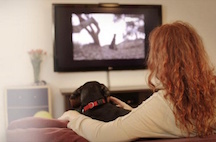 What TV Shows Do You Watch With Your Pet?
What TV Shows Do You Watch With Your Pet?
Netflix did a survey recently questioning pet lovers about how and what they like to watch with their furry best friends. Here's what they found out - when it comes to watching TV, most people (71-percent) find pets to be the best binge partner. But it doesn't stop there, 27-percent have even talked to their pet about the show or movie they were watching. According to the survey, dog owners are more likely to choose action shows like Narcos and Marvel's Daredevil. But if you're wondering what shows had everyone and their furry friends watching together, here are the top 10 in the US: 1. Stranger Things; 2. Fuller House; 3. 13 Reasons Why; 4. Orange is the New Black; 5. House of Cards; 6. Black Mirror; 7. Marvel's Daredevil; 8. A Series of Unfortunate Events; 9. The Ranch; and 10. Better call Saul.
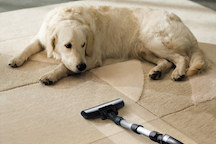 Think About Your Pets When Buying That Tech Gadget
Think About Your Pets When Buying That Tech Gadget
You will now want to consider your pet before going out and buying the newest tech gadget for your home. Tech expert Kim Komando says every piece of technology we put into our homes could very easily emit a sound that cannot be heard by humans but comes in loud and clear for pets. That's not to say pets are suffering because of our gadgets, but that the possibility exists and it is something you may want to consider. Komando says there's a reason dog whistles exist and why the vacuum cleaner is one of dogs greatest rivals, because dogs hear better than humans. In scientific terms, humans can hear sounds up to about 20,000 Hz, while dogs can hear sounds up to 45,000 Hz and cats 64,000 Hz. That means there are frequencies undetectable to us but very noticeable and even hurtful to animals. Unfortunately for our pets, manufacturers design things for humans, not for them. A number of studies have been done to try and determine what kind of impact noise has on animals. One done in 2005 by Dr. Jeremy G. Turner of the Southern Illinois University School of Medicine Department of Pharmacology, concluded that it can lead to issues with animals' hearts, sleep and endocrine cycles while making them more susceptible to seizures. Lights can also be a problem, because animals see the world differently than humans. Flickering lights can be problematic, which is bad news for pets whose owners use LED bulbs in their home. Some LED lights flicker more than others, though the speed at which they do so isn't really noticed by humans. For us, about 24 Hz or "flickers" per second will look steady. Komando says that is similar to frames-per-second with video, which is more than enough for us to feel like it looks right. Dogs, however, are sensitive up to 80 Hz or flickers per second.
 Listen to the entire Podcast of this show (#960)
Listen to the entire Podcast of this show (#960)





